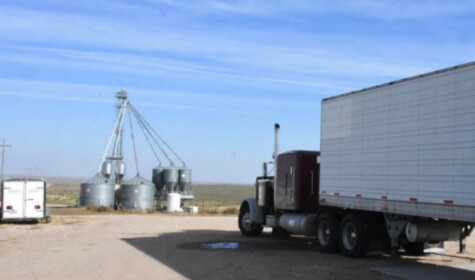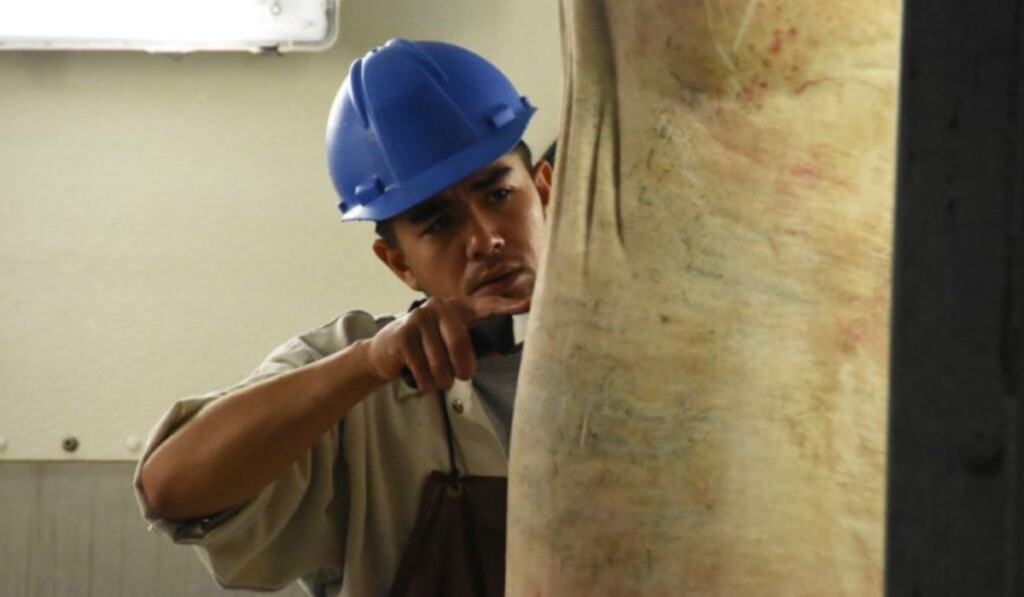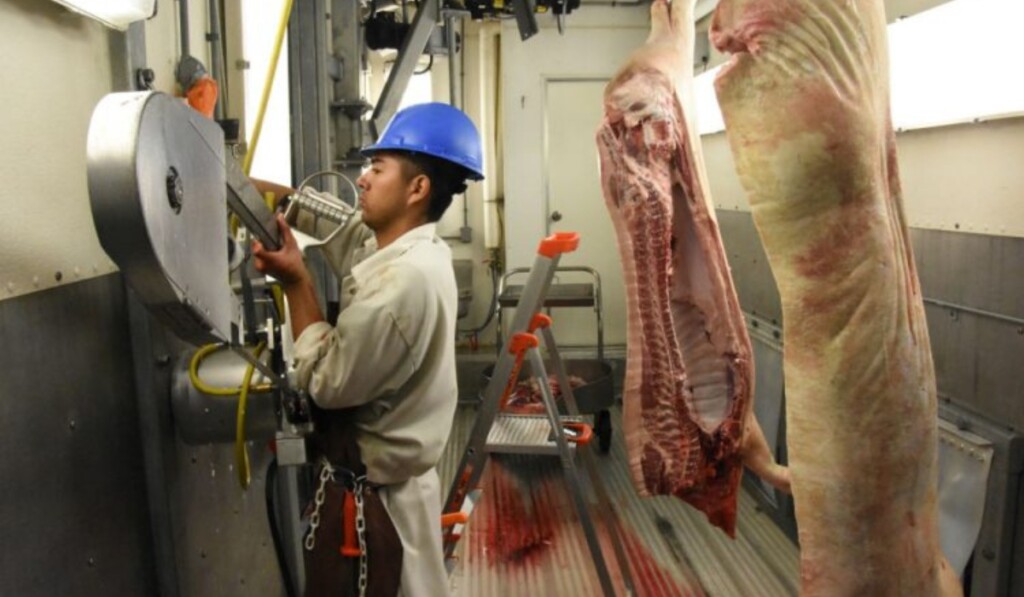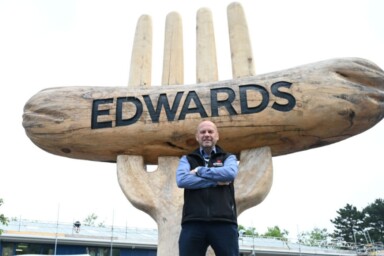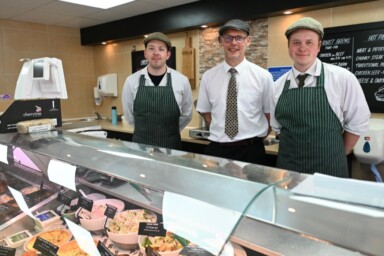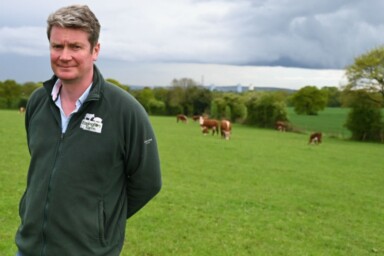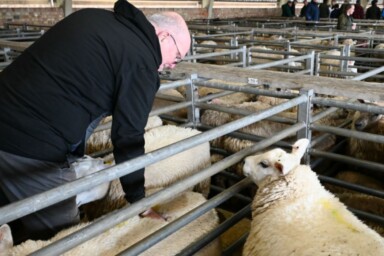Local food systems are often seen as the basis for a sustainable future, yet for them to succeed it needs the infrastructure that enables farmers to produce, process and market their food locally. For livestock farmers, the decline of local slaughtering facilities and the consolidation of meat processing in vast slaughterhouses, sometimes hundreds of miles from the farm, jeopardises the whole concept of local meat. Marianne Landzettel visits one US farm with a novel solution – a mobile on-farm slaughter unit. Such units enable farmers to slaughter on-site then transport carcasses rather than live animals to their local processing plant. How exactly does this system work? And could it revolutionise the future of local food?
The carcass of the pig hangs from the ceiling; a slaughterman carefully opens the body cavity and removes the organs which are placed in a special tray, ready for inspection by the on-duty veterinarian from the US Department of Agriculture (USDA). The pig and the surrounding area are hosed down with hot water before he cuts through the spine with an electric saw and moves the pig halves into the cooler compartment. It’s standard protocol for slaughter – except that this slaughterman doesn’t work on a line in an abattoir, but in a mobile slaughter unit. It’s a fully functional facility installed in a large truck trailer (a ‘semi’ in US parlance).
It’s Tuesday morning on Mike Callicrate’s farm just outside St. Francis, a small town in north-western Kansas just a few miles from the border to neighbouring Colorado. He runs a small feedlot and produces about 800 pigs per year. Cattle and pigs are slaughtered on farm in the mobile unit which goes back and forth between the farm and his processing facility in Colorado Springs where different cuts of meat are packed and sausages and hamburger patties produced.
Callicrate has not always marketed his meat directly, and he certainly had no ambition to run his own slaughter facility. He grew up on a ranch in Colorado, but after college he worked in a number of different fields – at one point, he was a professional bull rider – until he married and moved to St. Francis, taking on the management of his wife’s family farm.
In the late 1980s, while the consolidation in the US meat market accelerated, more and more family-run slaughter facilities and processors were forced out of business or were bought up. The few remaining big meatpacking companies started to flex their muscles. Callicrate says that when he started ranching, he had the choice of selling to about 20 different packing companies in Texas, Kansas, Nebraska and Colorado, but by the 1990s only a few conglomerates were left, and the cattlemen felt the effect: in the 1970s, 70% of the profit from meat sales went to producers, today, he says, it’s 30%. After he joined a class action lawsuit against the food company and meat processor Tyson with charges of price fixing and acting as a monopoly against the interests of producers and consumers, Callicrate found that he was unable to sell his cattle anywhere.
He wasn’t the only one, even ranchers not involved in the lawsuit struggled, says Laura Krebsbach, a trained paralegal who came up with the idea of a mobile slaughter unit in 2004. Callicrate’s unit is one of hers. Together with a small group of co-creators, she holds patents on the design of the unit. In the early 2000s, Krebsbach was based in Nebraska, working for a farm advocacy group. “The big meat processors flooded the market with cheap meat,” she says. “Farmers either went with these big companies, or they had no access to the markets. The USDA run facilities closed one by one. For farmers, there was no way to get animals to slaughter.” Krebsbach’s goal was to give farmers market access, so they could directly market their meat. A mobile slaughter unit seemed like an obvious solution. To work out what specifications such a unit needed, in order to be efficient and get the necessary USDA approval, she assembled a small group of experts and farmers – one of them was Mike Callicrate.
The HACCP (Hazard Analysis and Critical Control Point) system establishes the ground rules: the unit had to be high enough to hang a beef carcass; the workspace had to progress from dirty to clean to cleaner, with the carcass, finally, going to the chiller. The animal’s head and organs also had to be presented to the USDA veterinarian for inspection. Hot water (82°C or 180°F) needs to be available at all times and there has to be a backup generator, should the outside on-farm power supply fail.
Krebsbach managed to source six custom built so-called ‘drop deck’ or ‘drop belly’ reefers (refrigerated trailers for articulated lorries) from a meat processor that had switched to a new system and didn’t need them anymore. The reefers had been used to transport sides of beef from small slaughter facilities to bigger processing plants. They had lowered axels to provide the required extra height and a reinforced hull and rails on which the carcasses could be moved.
The mobile slaughter unit can be operational pretty much anywhere, with access to water and electricity, but a few things need to be in place around the unit: a corral has to be set up so that the animals can be delivered the day before and have space to rest; and there has to be a chute, a metal enclosure in which to restrain an animal for stunning, that also serves as a kill box. The whole unit can be adapted for the slaughter of cattle, pigs or sheep and operated by just two skilled slaughtermen.
Once the animal has been stunned and killed, a front loader lifts the carcass so that it can be attached to the movable rail that extends from the slaughter unit. When the animal is bled out, it is transferred into the unit, the doors are closed and the carcass can start to be processed. The cattle hide is removed inside the trailer, pigs will be scaled and the bristles removed outside.
On Callicrate’s farm, the unit is in use five days a week, with cattle and pigs being slaughtered on alternate days. With the ranch in north-western Kansas and the processing facility in Colorado Springs, the mobile slaughter unit is the link that connects both operations and makes them into a seamlessly functioning, economically viable system.
Callicrate has set up a standard warehouse/docking station for the reefer. While the work could be done outside, having protection from the weather makes things a lot easier. With four people working outside the reefer in the warehouse and one inside, 20 pigs or 10 head of cattle can be slaughtered in a day.
What about meat inspection? The USDA is required by law to provide an inspector for eight hours a day without extra cost. “Initially, the veterinarians were really unhappy,” says Krebsbach, “they considered it an expensive waste of time. But it didn’t take long until they started to volunteer for shifts at the mobile units, saying ‘we are actually doing our job here!’ In a big [slaughterhouse], they are usually just on the kill floor because they are only authorized to intervene when they see inhumane killing – even if they see meat contaminated with faeces, they cannot halt the line.”
In the mobile unit every animal is thoroughly inspected – and given the number of meat recalls and salmonella outbreaks through contaminated meat in the US in recent years, customers do care about and pay attention to food safety procedures. Only a month ago a company in Arizona had to recall some 7 million pounds of beef mince (approximately 3,200 tonnes) deemed dangerous to human health.
The mobile slaughter units Laura Krebsbach and her team refurbished in 2004, at a cost of $130,000 a piece, are all still in operation across the US and there is demand for more. The reason the units could be made so cheaply was that the company at the time wanted to get rid of the ‘drop belly’ reefers and was happy to sell them off for just $ 5,000. Krebsbach has been trying to buy more but says, “They seem to have vanished from the face of the earth.” According to the company, the reefers were sold to Mexico – except that not one of them could be traced there. And new ones aren’t an option either: the only company that was prepared to build new units – at a cost of $100,000 each – withdrew the offer when Krebsbach wanted to order ten. The million dollar order was suddenly considered too small and not worth the company’s effort.
Laura Krebsbach and her colleagues knew back in 2004 that the meat industry giants wouldn’t be happy about mobile slaughter units suddenly giving back market access to farmers and ranchers. “We took out patents on the unit, so that no one in the industry could shut us down on patent infringement,” she says. The slaughter units helped Mike Callicrate save the ranch after the large meat processors refused to work with him. The mobile abattoirs allowed him to get back into the meat business and build up a direct marketing chain.
But would mobile slaughter units work in other countries? Could they be an option for remote areas in Britain where small abattoirs are closing with great frequency? Laura Krebsbach thinks a mobile unit would definitely be an option for the UK. The US design has been tried and tested, but in other countries regulations and practicalities may differ, requiring changes to the design. However, she is confident that those issues could be worked out. And she’s even offered to help – for free. “This is my passion,” she says “farmers need market access.”
